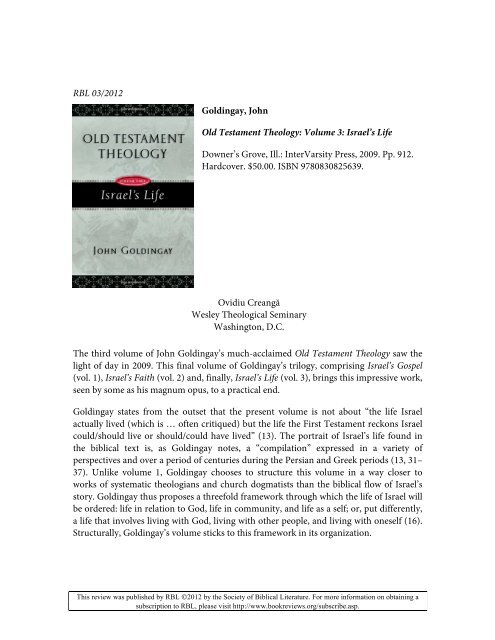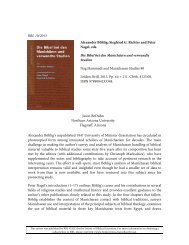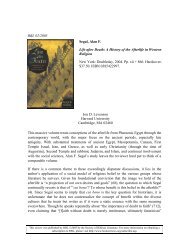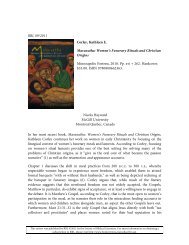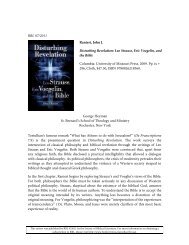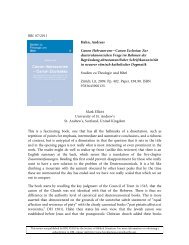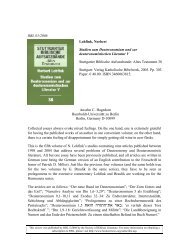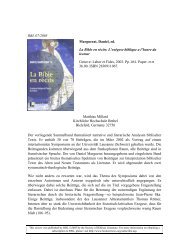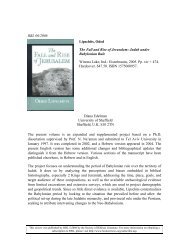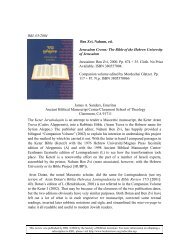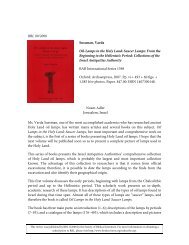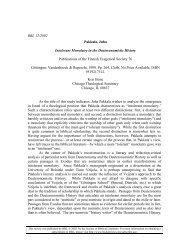Read the Review - Review of Biblical Literature
Read the Review - Review of Biblical Literature
Read the Review - Review of Biblical Literature
You also want an ePaper? Increase the reach of your titles
YUMPU automatically turns print PDFs into web optimized ePapers that Google loves.
RBL 03/2012<br />
Goldingay, John<br />
Old Testament Theology: Volume 3: Israel’s Life<br />
Downer’s Grove, Ill.: InterVarsity Press, 2009. Pp. 912.<br />
Hardcover. $50.00. ISBN 9780830825639.<br />
Ovidiu Creangă<br />
Wesley Theological Seminary<br />
Washington, D.C.<br />
The third volume <strong>of</strong> John Goldingay’s much-acclaimed Old Testament Theology saw <strong>the</strong><br />
light <strong>of</strong> day in 2009. This final volume <strong>of</strong> Goldingay’s trilogy, comprising Israel’s Gospel<br />
(vol. 1), Israel’s Faith (vol. 2) and, finally, Israel’s Life (vol. 3), brings this impressive work,<br />
seen by some as his magnum opus, to a practical end.<br />
Goldingay states from <strong>the</strong> outset that <strong>the</strong> present volume is not about “<strong>the</strong> life Israel<br />
actually lived (which is … <strong>of</strong>ten critiqued) but <strong>the</strong> life <strong>the</strong> First Testament reckons Israel<br />
could/should live or should/could have lived” (13). The portrait <strong>of</strong> Israel’s life found in<br />
<strong>the</strong> biblical text is, as Goldingay notes, a “compilation” expressed in a variety <strong>of</strong><br />
perspectives and over a period <strong>of</strong> centuries during <strong>the</strong> Persian and Greek periods (13, 31–<br />
37). Unlike volume 1, Goldingay chooses to structure this volume in a way closer to<br />
works <strong>of</strong> systematic <strong>the</strong>ologians and church dogmatists than <strong>the</strong> biblical flow <strong>of</strong> Israel’s<br />
story. Goldingay thus proposes a threefold framework through which <strong>the</strong> life <strong>of</strong> Israel will<br />
be ordered: life in relation to God, life in community, and life as a self; or, put differently,<br />
a life that involves living with God, living with o<strong>the</strong>r people, and living with oneself (16).<br />
Structurally, Goldingay’s volume sticks to this framework in its organization.<br />
This review was published by RBL ©2012 by <strong>the</strong> Society <strong>of</strong> <strong>Biblical</strong> <strong>Literature</strong>. For more information on obtaining a<br />
subscription to RBL, please visit http://www.bookreviews.org/subscribe.asp.
Thus, after an introduction meant to quickly familiarize <strong>the</strong> reader with <strong>the</strong> overarching<br />
<strong>the</strong>mes <strong>of</strong> this Old Testament Theology and <strong>the</strong> issues postmodernity brings to a<br />
<strong>the</strong>ologian (13–50), part 1 <strong>of</strong> this volume (“Living with God,” 51–322) treats vertical<br />
aspects <strong>of</strong> how Israel ought to live before God. This should be, chiefly, a life defined by<br />
“submission and celebration,” punctuated by obedience, reverence, trust, servitude,<br />
giving, as well as sojourning with and <strong>the</strong> praising <strong>of</strong> God (53–190). Equally, it also<br />
should be a life <strong>of</strong> “prayer and thanksgiving” in which communication, protest, and plea<br />
mix with confidence, intercession, penitence, and thanksgiving (191–322).<br />
Part 2 (“Living with One Ano<strong>the</strong>r,” 323–582) engages horizontal relations <strong>of</strong> a social and<br />
political nature. Goldingay begins with <strong>the</strong> nucleus <strong>of</strong> all social life, “family and<br />
community,” in which he considers important topics <strong>of</strong> marriage, family, community<br />
(understood as a series <strong>of</strong> broader human relations beyond immediate kin and<br />
household), and servanthood (350–476). He <strong>the</strong>n moves on to wider human<br />
organizations, such as “city and nation” (477), where <strong>the</strong> focus is on <strong>the</strong> village, city,<br />
nation, and kingdom (477–582). Before tackling potentially sensitive topics <strong>of</strong> <strong>the</strong><br />
postmodern life, such as debates about what constitutes marriage or how gender roles<br />
should be envisioned by a modern family, Goldingay is careful to write down <strong>the</strong><br />
principles that guide him when discerning “what <strong>the</strong> First Testament has to say to <strong>the</strong> life<br />
<strong>of</strong> <strong>the</strong> third millennium world” (326–50). This is <strong>the</strong> closest Goldingay gets to laying<br />
down “ethical” principles in this volume (which some reviewers wrongly claim to<br />
comprise Goldingay’s “ethics”; he actually dislikes <strong>the</strong> rigidity <strong>the</strong> term implies).<br />
Part 3 (“Living with Oneself,” 583–831), <strong>the</strong> largest <strong>of</strong> <strong>the</strong> book’s parts, narrows in on <strong>the</strong><br />
self—not as an isolated entity but as one person living among and for o<strong>the</strong>rs and before<br />
God. In <strong>the</strong> first section <strong>of</strong> part 3 Goldingay nuances how various texts speak about<br />
“spirituality and character” in virtues such as godliness, holiness, and purity, as well as in<br />
cultivating a healthy relationship with life and death and with time and material<br />
possessions. In addition, he examines how one acquires wisdom or insight, how one is to<br />
use <strong>the</strong> mouth (words) when speaking, and how one is to suffer “well” (i.e., cope with,<br />
and retain most benefits from, suffering, 585–707), so that God’s people exhibit what God<br />
“looks for” (699–707). The final section in part 3 concerns “leaders and servants.” This<br />
gives Goldingay an opportune occasion for a discussion <strong>of</strong> governing and government<br />
with its inherent institutions in <strong>the</strong> First Testament, but with a critical eye to its<br />
limitations and propensity for abusing power (708–831).<br />
After filling up over 800 pages, Goldingay <strong>of</strong>fers a ra<strong>the</strong>r short conclusion meant to<br />
briefly recapture <strong>the</strong> vision tying all three volumes toge<strong>the</strong>r (832–39). Fur<strong>the</strong>r, it invites<br />
<strong>the</strong> reader to practice, not just retain in <strong>the</strong> mind, <strong>the</strong> principles that God intended for<br />
This review was published by RBL ©2012 by <strong>the</strong> Society <strong>of</strong> <strong>Biblical</strong> <strong>Literature</strong>. For more information on obtaining a<br />
subscription to RBL, please visit http://www.bookreviews.org/subscribe.asp.
Israel to live out and live by. A complete bibliography (841–72) is followed by author,<br />
subject, and scripture indices (895–912).<br />
Overall, Israel’s Life is just as worthy <strong>of</strong> praise as <strong>the</strong> o<strong>the</strong>r two volumes <strong>of</strong> Goldingay’s<br />
Old Testament Theology. In terms <strong>of</strong> <strong>the</strong> <strong>the</strong>mes it examines, this volume constitutes a<br />
critical part <strong>of</strong> any serious attempt at writing a <strong>the</strong>ology <strong>of</strong> <strong>the</strong> Hebrew Scriptures.<br />
Methodologically, it remains in line with <strong>the</strong> o<strong>the</strong>r volumes, in that it approaches each<br />
topic from a literary (received text) point <strong>of</strong> view and with discerning attention to <strong>the</strong><br />
limitations and ambiguities inherent <strong>the</strong>rein. (<strong>Read</strong>ers interested to know more about<br />
how volumes 1 and 2 link up with volume 3 may want to consult <strong>the</strong> reviews <strong>of</strong> Daniel<br />
Doleys at http://textcommunitymission.wordpress.com/2010/05/07/review-<strong>of</strong>review-<strong>of</strong>old-testament-<strong>the</strong>ology-israels-gospel-by-john-goldingay<br />
and Stephen A. Reed at http://<br />
bookreviews.org/pdf/5616_6201.pdf.<br />
By <strong>the</strong> same token, <strong>the</strong> same critiques said about <strong>the</strong> first two volumes could be applied to<br />
<strong>the</strong> third. The statement, “Goldingay spends most attention on <strong>the</strong> final level <strong>of</strong> <strong>the</strong><br />
biblical text and does not base <strong>the</strong>ological reflection on earlier levels <strong>of</strong> text,” which<br />
Stephen A. Reed makes in connection to volume 2, applies also to volume 3. The same<br />
goes for <strong>the</strong> usage <strong>of</strong> terminology, for example, <strong>the</strong> use <strong>of</strong> “First Testament” in <strong>the</strong> body <strong>of</strong><br />
<strong>the</strong> work but “Old Testament” in <strong>the</strong> title, and <strong>the</strong> use <strong>of</strong> “New Testament” throughout<br />
<strong>the</strong> pages <strong>of</strong> this volume instead <strong>of</strong> “Second Testament,” if sensitivity to a particular<br />
readership was intended in <strong>the</strong> first place. Finally, <strong>the</strong> sparse incorporation <strong>of</strong><br />
deuterocanonical/apocryphal works and <strong>the</strong> use <strong>of</strong> <strong>the</strong> ancient Near Eastern world as a<br />
point <strong>of</strong> comparison in volumes 1 and 2 (that both Reed’s and Doleys’s reviews touched<br />
on) remain unchanged in <strong>the</strong> case <strong>of</strong> volume 3. (Those few citations that exist, including<br />
those one or two Mishnaic references, are not entered in <strong>the</strong> index <strong>of</strong> scripture. Is it<br />
because <strong>the</strong>y find no place in Goldingay’s Protestant canon, or is it an editorial error?)<br />
There are, however, additional issues in volume 3 for Jewish and evangelical readers alike.<br />
One <strong>of</strong> <strong>the</strong> excerpts on <strong>the</strong> back cover (by John Barton) asserts, “Christians and Jews alike<br />
will need to ponder this challenging book.” Yet <strong>the</strong> contents and point <strong>of</strong> view <strong>of</strong> this<br />
work are unapologetically Christian (Protestant evangelical, to be precise). At least this<br />
feature (if not a more extensive engagement with <strong>the</strong> rabbinic sources) will make <strong>the</strong><br />
volume somewhat challenging for many Jewish readers. This is not to say that Goldingay<br />
disproportionately allocates time to New Testament views, because he does not, yet he<br />
himself admits this much about this volume: “In Israel’s Life I have woven more<br />
references to <strong>the</strong> New Testament throughout because <strong>the</strong> material seemed to point in that<br />
direction” (832). As a Protestant evangelical scholar, Goldingay is perfectly entitled to his<br />
choice, but should we not <strong>the</strong>n be cautious in calling upon Jewish scholars to read it?<br />
Related to his choice <strong>of</strong> approach, perhaps Goldingay could have done more to locate<br />
This review was published by RBL ©2012 by <strong>the</strong> Society <strong>of</strong> <strong>Biblical</strong> <strong>Literature</strong>. For more information on obtaining a<br />
subscription to RBL, please visit http://www.bookreviews.org/subscribe.asp.
himself within <strong>the</strong> Christian spectrum and explain how his evangelical beliefs commit<br />
him to seeing <strong>the</strong> First Testament “pointing” in <strong>the</strong> direction <strong>of</strong> <strong>the</strong> New Testament. It is<br />
clear from his views on marriage, cohabitation, same-sex union, and divorce, to name<br />
only some <strong>of</strong> <strong>the</strong> most conspicuous, that he echoes Protestant evangelical ideals, so why<br />
not put that on <strong>the</strong> table and make a <strong>the</strong>ological point <strong>of</strong> one’s confessional belief. After<br />
decades <strong>of</strong> a reflexive turn in academia, is it not valuable to clearly state one’s confessional<br />
background and how this affects one’s approach to <strong>the</strong> Bible?<br />
Finally, to Goldingay’s credit, <strong>the</strong> Protestant evangelical stance from which he writes<br />
about geopolitics and <strong>the</strong> (failing) Western order is not only visionary but also<br />
courageous and counterintuitive to how many Protestant evangelicals think about <strong>the</strong><br />
world. He will disappoint many conservative evangelical circles who would like to see<br />
<strong>the</strong>ir beliefs legislated when he writes that “[t]he state is not responsible for people’s<br />
obedience to <strong>the</strong> Torah” (331). Advocating for a bottom-up approach to morality in <strong>the</strong><br />
public sphere, and putting more emphasis on local communities as places for <strong>the</strong> teaching<br />
<strong>of</strong> morality and religion, is a more biblical approach than a top-down enforcement <strong>of</strong> any<br />
one morality.<br />
Each <strong>of</strong> <strong>the</strong> three volumes <strong>of</strong> John Goldingay’s Old Testament Theology makes an<br />
excellent resource for teaching and preaching. One can build on a volume’s structure to<br />
construe course curriculum and sermon series with relative ease. In its entirety, this<br />
ample work has won its distinct place among Old Testament <strong>the</strong>ologies and will not be<br />
dethroned any time soon.<br />
This review was published by RBL ©2012 by <strong>the</strong> Society <strong>of</strong> <strong>Biblical</strong> <strong>Literature</strong>. For more information on obtaining a<br />
subscription to RBL, please visit http://www.bookreviews.org/subscribe.asp.


